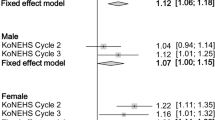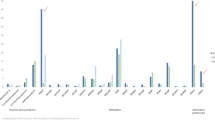Abstract
Human exposure to Bisphenol A (BPA) is omnipresent. Both the extent of the exposure and its toxicological relevance are controversially discussed. We aim to reliably determine and evaluate the extent of BPA body burden in the German population from 1995 to 2009 based on 600 24 h urine samples and corresponding plasma samples from the Environmental Specimen Bank. We determined total and unconjugated BPA in urine and plasma using on-line solid-phase extraction high-performance liquid chromatography coupled to isotope dilution tandem mass spectrometry with a limit of quantification (LOQ) of 0.1 μg/l. In the stored urines, total BPA was quantifiable in >96% (median: 1.49 μg/l; 95th percentile: 7.37 μg/l), whereas unconjugated BPA was quantifiable only in <15% of the samples. Total BPA concentrations decreased over time, but 24 h urine volumes increased. Therefore, daily intakes calculated from the 24 h urines remained rather constant at a median of 0.037 and a 95th percentile of 0.171 μg BPA/kg body weight/day. In 60 corresponding plasma samples, total BPA levels were generally below the LOQ of 0.1 μg/l and, if quantifiable, most BPA was unconjugated, thus hinting to external contamination. We see total BPA in urine as the most appropriate and robust marker for BPA exposure assessment (if controlled for BPA contamination). Unconjugated BPA in urine and unconjugated or total BPA in plasma where contamination or breakdown of the glucuronide cannot be ruled out are of no value for human exposure assessment.
This is a preview of subscription content, access via your institution
Access options
Subscribe to this journal
Receive 6 print issues and online access
$259.00 per year
only $43.17 per issue
Buy this article
- Purchase on Springer Link
- Instant access to full article PDF
Prices may be subject to local taxes which are calculated during checkout



Similar content being viewed by others
References
CERHR. NTP-CERHR Expert Panel Report on the Reproductive and Developmental Toxicity of Bisphenol A. National Toxicology Program, U.S. Department of Health and Human Services, Research Triangle Park, NC. Available: http://cerhr.niehsnih.gov/chemicals/bisphenol/BPAFinalEPVF112607.pdf [accessed 26 November 2007]. 2007.
European Union. 2003 EU Risk Assessment report- BPA. European Union. Available: http://ecb.jrc.it/DOCUMENTS/Existing-Chemicals/RISK_ASSESSMENT/REPORT/bisphenolareport325.pdf [accessed 21 May 2007].
Becker K., Goen T., Seiwert M., Conrad A., Pick-Fuss H., and Muller J., et al. GerES IV: phthalate metabolites and bisphenol A in urine of German children. Int J Hyg Environ Health 2009: 212: 685–692.
Fourth National Report on Human Exposure to Environmental Chemicals - Updated Tables (February 2011). Available: http://www.cdc.gov/exposurereport/ file: http://www.cdc.gov/exposurereport/pdf/FourthReport_UpdatedTables_Feb2012.pdf.
Report on Human Biomonitoring of Environmental Chemicals in Canada. Results of the Canadian Health Measures Survey Cycle 1 (2007-2009) Available: http://www.hc-sc.gc.ca/ file: http://www.hc-sc.gc.ca/ewh-semt/alt_formats/hecs-sesc/pdf/pubs/contaminants/chms-ecms/report-rapport-eng.pdf.
Vandenberg L.N., Chahoud I., Heindel J.J., Padmanabhan V., Paumgartten F.J., and Schoenfelder G. Urinary, circulating, and tissue biomonitoring studies indicate widespread exposure to bisphenol A. Environ Health Perspect 2010a: 118: 1055–1070.
Koch H.M., and Calafat A.M. Human body burdens of chemicals used in plastic manufacture. Philos Trans R Soc Lond B Biol Sci 2009: 364: 2063–2078.
Lakind J.S., and Naiman D.Q. Daily intake of bisphenol A and potential sources of exposure: 2005-2006 National Health and Nutrition Examination Survey. J Expo Sci Environ Epidemiol 2011: 21 (3): 272–279.
Vandenberg L.N., Hauser R., Marcus M., Olea N., and Welshons W.V. Human exposure to bisphenol A (BPA). Reprod Toxicol 2007: 24: 139–177.
Angerer J., Bird M.G., Burke T.A., Doerrer N.G., Needham L., and Robison S.H., et al. Strategic biomonitoring initiatives: moving the science forward. Toxicol Sci 2006: 93: 3–10.
Needham L.L., Calafat A.M., and Barr D.B. Uses and issues of biomonitoring. Int J Hyg Environ Health 2007: 210: 229–238.
Ye X.Y., Zhou X.L., Needham L.L., and Calafat A.M. In-vitro oxidation of bisphenol A: is bisphenol A catechol a suitable biomarker for human exposure to bisphenol A? Anal Bioanal Chem 2011: 399: 1071–1079.
Dekant W., and Volkel W. Human exposure to bisphenol A by biomonitoring: methods, results and assessment of environmental exposures. Toxicol App Pharmacol 2008: 228: 114–134.
Volkel W., Colnot T., Csanady G.A., Filser J.G., and Dekant W. Metabolism and kinetics of bisphenol A in humans at low doses following oral administration. Chem Res Toxicol 2002: 15: 1281–1287.
Ye X.Y., Kuklenyik Z., Needham L.L., and Calafat A.M. Quantification of urinary conjugates of bisphenol A, 2,5-dichlorophenol, and 2-hydroxy-4-methoxybenzophenone in humans by online solid phase extraction-high performance liquid chromatography-tandem mass spectrometry. Anal Bioanal Chem 2005: 383: 638–644.
Schonfelder G., Wittfoht W., Hopp H., Talsness C.E., Paul M., and Chahoud I. Parent bisphenol A accumulation in the human maternal-fetal-placental unit. Environ Health Perspect 2002: 110: A703–A707.
Volkel W., Bittner N., and Dekant W. Quantitation of bisphenol A and bisphenol A glucuronide in biological samples by high performance liquid chromatography-tandem mass spectrometry. Drug Metabol Dispos 2005: 33: 1748–1757.
Volkel W., Kiranoglu M., and Fromme H. Determination of free and total bisphenol A in human urine to assess daily uptake as a basis for a valid risk assessment. Toxicol Lett 2008: 179: 155–162.
vom Saal F.S., Akingbemi B.T., Belcher S.M., Birnbaum L.S., Crain D.A., and Eriksen M., et al. Chapel Hill bisphenol A expert panel consensus statement: integration of mechanisms, effects in animals and potential to impact human health at current levels of exposure. Reprod Toxicol 2007: 24: 131–138.
Waechter J., Domoradzki J., Thornton C., and Markham D. Factors affecting the accuracy of bisphenol a and bisphenol a-monoglucuronide estimates in mammalian tissues and urine samples. Toxicol Mech Methods 2007: 17: 13–24.
Wittassek M., Wiesmuller G.A., Koch H.M., Eckard R., Dobler L., and Muller J., et al. Internal phthalate exposure over the last two decades--a retrospective human biomonitoring study. Int J Hyg Environ Health 2007b: 210: 319–333.
Wiesmuller G.A., Eckard R., Dobler L., Gunsel A., Oganowski M., and Schroter-Kermani C., et al. The Environmental Specimen Bank for Human Tissues as part of the German Environmental Specimen Bank. Int J Hyg Environ Health 2007: 210: 299–305.
Koch H.M., Gonzalez-Reche L.M., and Angerer J. On-line clean-up by multidimensional liquid chromatography-electrospray ionization tandem mass spectrometry for high throughput quantification of primary and secondary phthalate metabolites in human urine. J Chromatogr B Analyt Technol Biomed Life Sci 2003: 784: 169–182.
Koch H.M., Bolt H.M., and Angerer J. Di(2-ethylhexyl)phthalate (DEHP) metabolites in human urine and serum after a single oral dose of deuterium-labelled DEHP. Arch Toxicol 2004: 78: 123–130.
Ye X., Tao L.J., Needham L.L., and Calafat A.M. Automated on-line column-switching HPLC-MS/MS method for measuring environmental phenols and parabens in serum. Talanta 2008: 76: 865–871.
Calafat A.M., Weuve J., Ye X.Y., Jia L.T., Hu H., and Ringer S., et al. Exposure to bisphenol A and other phenols in neonatal intensive care unit premature infants. Environ Health Perspect 2009: 117: 639–644.
Kim Y.H., Kim C.S., Park S., Han S.Y., Pyo M.Y., and Yang M.H. Gender differences in the levels of bisphenol A metabolites in urine. Biochem Biophys Res Commun 2003: 312: 441–448.
Koch H.M., Becker K., Wittassek M., Seiwert M., Angerer J., and Kolossa-Gehring M. Di-n-butylphthalate and butylbenzylphthalate - urinary metabolite levels and estimated daily intakes: pilot study for the German Environmental Survey on children. J Exp Sci Envirom Epidemiol 2007: 17: 378–387.
Wittassek M., Heger W., Koch H.M., Becker K., Angerer J., and Kolossa-Gehring M. Daily intake of di(2-ethylhexyl)phthalate (DEHP) by German children -- a comparison of two estimation models based on urinary DEHP metabolite levels. Int J Hyg Environ Health 2007a: 210: 35–42.
Wittassek M., Koch H.M., Angerer J., and Brüning T. Assessing exposure to phthalates - the human biomonitoring approach. Mol Nutr Food Res 2011: 55: 7–31.
Goen T., Dobler L., Koschorreck J., Muller J., Wiesmuller G.A., and Drexler H., et al. Trends of the internal phthalate exposure of young adults in Germany--follow-up of a retrospective human biomonitoring study. Int J Hyg Environ Health 2011: 215: 36–45.
EFSA. Opinion of the Scientific Panel on Food Additives, Flavourings, Processing Aids and Materials in Contact with Food on a request from the Commission related to 2,2-Bis(4-hydroxyphenyl)propane (Bisphenol A). Question number EFSA-Q-2005-100 adopted on 29 November 2006. EFSA J 2006: 428: 1–75.
EFSA. Scientific Opinion of the Panel on Food Additives, Flavourings, Processing Aids and Materials in Contact with Food (AFC) on a request from the Commission on the toxicokinetics of Bisphenol A. EFSA J 2008: 759: 1–10.
EPA, Integrated Risk Information System Bisphenol A (CASRN 80-05-7). US-EPA Integrated Risk Information System Substance File, 1993. Available: http://www.epa.gov/iris/subst/0356.htm [accessed 10 October 2011].
Volkel W., Kiranoglu M., and Fromme H. Determination of free and total bisphenol A in urine of infants. Environ Res 2011: 111: 143–148.
Hengstler J.G, Foth H, Gebel T, Kramer P.J, Lilienblum W, and Schweinfurth H, et al. Critical evaluation of key evidence on the human health hazards of exposure to bisphenol A. Crit Rev Toxicol 2011: 41: 263–291.
Vandenberg L.N., Chahoud I., Padmanabhan V., Paumgartten F.J., and Schoenfelder G. Biomonitoring studies should be used by regulatory agencies to assess human exposure levels and safety of bisphenol A. Environ Health Perspect 2010b: 118: 1051–1054.
Sieli P.T., Jasarevic E., Warzak D.A., Mao J., Ellersieck M.R., and Liao C., et al. Comparison of serum bisphenol A concentrations in mice exposed to bisphenol A through the diet versus oral bolus exposure. Environ Health Perspect 2011: 119: 1260–1265.
Taylor J.T., vom Saal F.S., Welshons W.V., Drury B., Rottinghaus G., and Hunt P.A., et al. Similarity of bisphenol A pharmacokinetics in rhesus monkeys and mice: relevance for human exposure. Environ Health Perspect 2011: 119: 422–430.
Bloom M.S., vom Saal F.S., Kim D., Taylor J.A., Lamb J.D., and Fujimoto V.Y. Serum unconjugated bisphenol A concentrations in men may influence embryo quality indicators during in vitro fertilization. Environ Toxicol Pharmacol 2011: 32: 319–323.
Teeguarden J.G., Calafat A.M., Ye X., Doerge D.R., Churchwell M.I., and Gunawan R., et al. Twenty-four hour human urine and serum profiles of bisphenol a during high-dietary exposure. Toxicol Sci 2011: 123: 48–57.
Acknowledgements
We thank Rolf Eckard, Gerhard Wiesmüller and Lorenz Dobler for their excellent work in acquiring, handling and storing the samples for the German Environmental Specimen Bank for Human Tissues.
Author information
Authors and Affiliations
Corresponding author
Ethics declarations
Competing interests
The authors declare no conflict of interest.
Rights and permissions
About this article
Cite this article
Koch, H., Kolossa-Gehring, M., Schröter-Kermani, C. et al. Bisphenol A in 24 h urine and plasma samples of the German Environmental Specimen Bank from 1995 to 2009: A retrospective exposure evaluation. J Expo Sci Environ Epidemiol 22, 610–616 (2012). https://doi.org/10.1038/jes.2012.39
Received:
Accepted:
Published:
Issue Date:
DOI: https://doi.org/10.1038/jes.2012.39
Keywords
This article is cited by
-
Systematic review of associations of polychlorinated biphenyl (PCB) exposure with declining semen quality in support of the derivation of reference doses for mixture risk assessments
Environmental Health (2022)
-
Human-Biomonitoring derived exposure and Daily Intakes of Bisphenol A and their associations with neurodevelopmental outcomes among children of the Polish Mother and Child Cohort Study
Environmental Health (2021)
-
Metabolites of the alkyl pyrrolidone solvents NMP and NEP in 24-h urine samples of the German Environmental Specimen Bank from 1991 to 2014
International Archives of Occupational and Environmental Health (2018)
-
Plastic toys as a source of exposure to bisphenol-A and phthalates at childcare facilities
Environmental Monitoring and Assessment (2018)
-
Daily intake and hazard index of parabens based upon 24 h urine samples of the German Environmental Specimen Bank from 1995 to 2012
Journal of Exposure Science & Environmental Epidemiology (2017)



